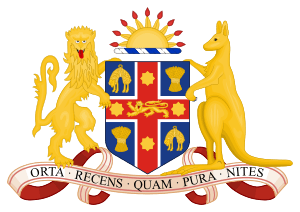Aboriginal Land Rights Act 1983 facts for kids
Quick facts for kids Aboriginal Land Rights Act 1983 |
|
|---|---|
 |
|
| Parliament of New South Wales | |
| An Act to repeal the Aborigines Act, 1969, and to make provisions with respect to the land rights of Aborigines, including provisions for, or with respect to Aboriginal Land Councils, the vesting of Land in those Councils, the acquisition of land by or for those Councils and the allocation of funds to or by those Councils; to amend certain other Acts; and to make provisions for certain other Purposes | |
| Date of Royal Assent | 4 May 1983 |
| Repealing legislation | |
| Aborigines Act 1969 | |
| Status: In force | |
The Aboriginal Land Rights Act 1983 is a special law from the Parliament of New South Wales in Australia. It was created to give land back to Aboriginal people. This happened by allowing them to claim certain government-owned lands. The Act also set up groups called Aboriginal Land Councils. This new law replaced an older one from 1969.
Why the Land Rights Act Was Needed
In 1977, a group called the NSW Aboriginal Land Council was formed. It was a non-government group that spoke up for Aboriginal people. More than 200 Aboriginal community leaders were part of this council. They worked hard to get land rights for Aboriginal people.
The Land Council convinced the New South Wales Government to look into the issue. In November 1978, a special group was set up. This group was called the Select Committee of the Legislative Assembly upon Aborigines.
The Committee looked into many problems faced by Aboriginal people. These included housing, health, education, and jobs. They also studied how the government handled Aboriginal affairs. A very important part of their work was looking at land rights. The Committee suggested creating a system for land rights in New South Wales. They also recommended setting up Aboriginal Regional Land Councils to help manage this system.
What the Act Does
The Aboriginal Land Rights Act 1983 made big changes. It got rid of the old Aborigines Act 1969. This new law brought in land rights for Aboriginal people in New South Wales.
The Act allowed new Aboriginal Land Councils to claim land. This land was given as a way to make up for land taken in the past. It also helps Aboriginal communities grow and develop. The Act also closed down the Aboriginal Lands Trust. This Trust used to hold land for Aboriginal reserves. Now, that land was given to the Minister for Aboriginal Affairs. From there, it was transferred to the new Aboriginal Land Councils.
The Act clearly states that land is very important to Aboriginal people. It says land has "spiritual, social, cultural, and economic importance." It also admits that "past Government decisions" had taken away land without paying for it. The Act lets Aboriginal people claim government land. This is land that is not needed for other important uses. Land Councils can only deal with land that has native title rights. This happens after a native title decision is made.
Changes to the Act
The Aboriginal Land Rights Amendment Act 2014 brought in some updates. These changes included new ways for Aboriginal Land Councils to make agreements about land. It also made sure that Local Aboriginal Land Councils report on their activities. The changes also made it clearer what Local Aboriginal Land Councils can do with businesses.

